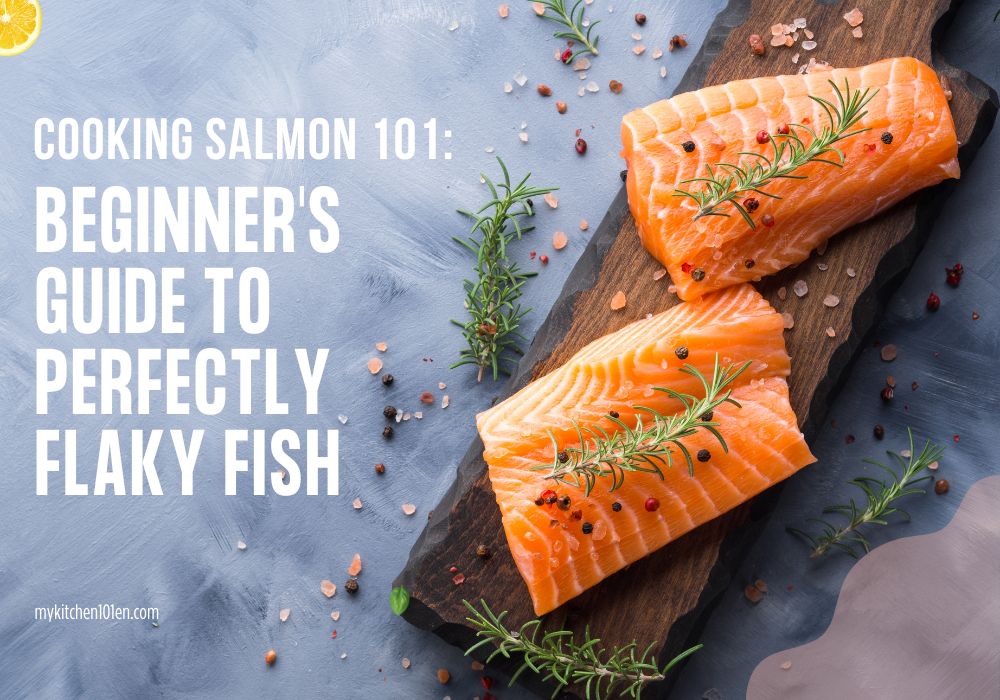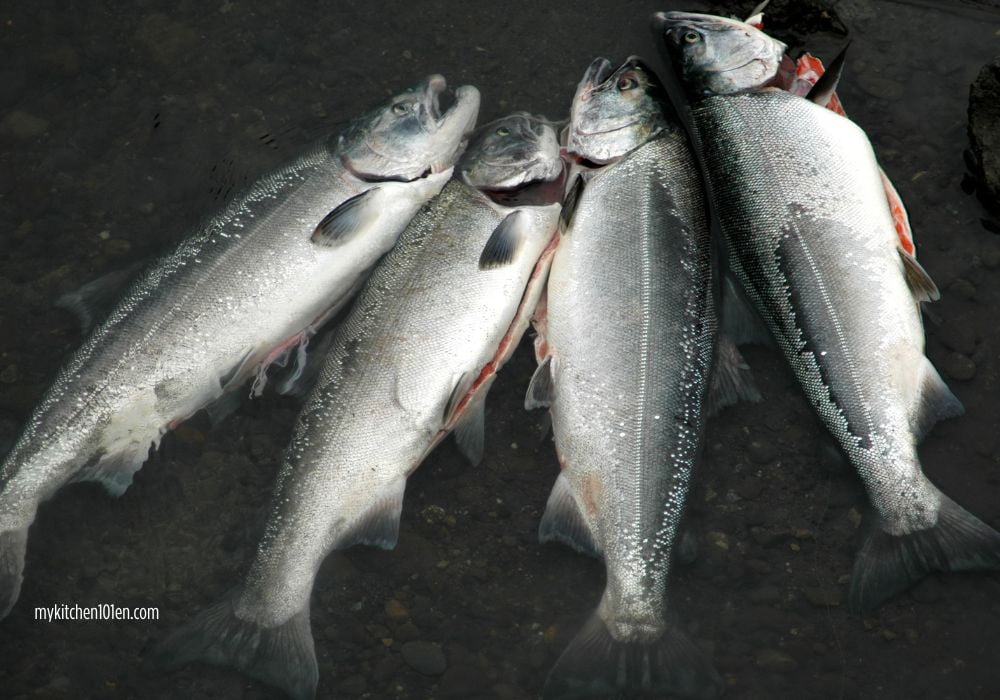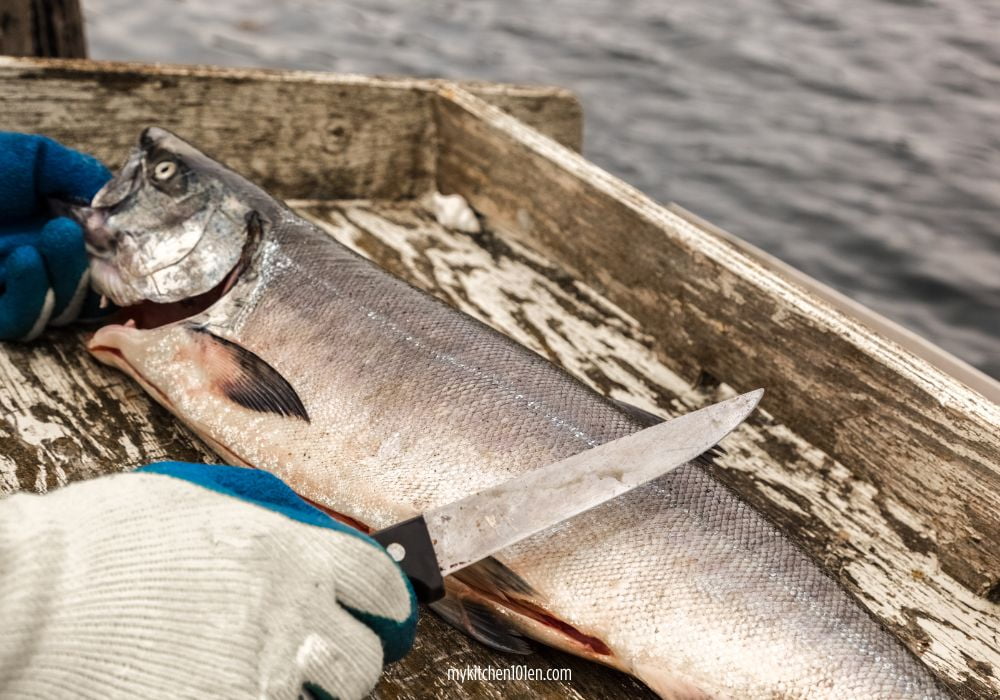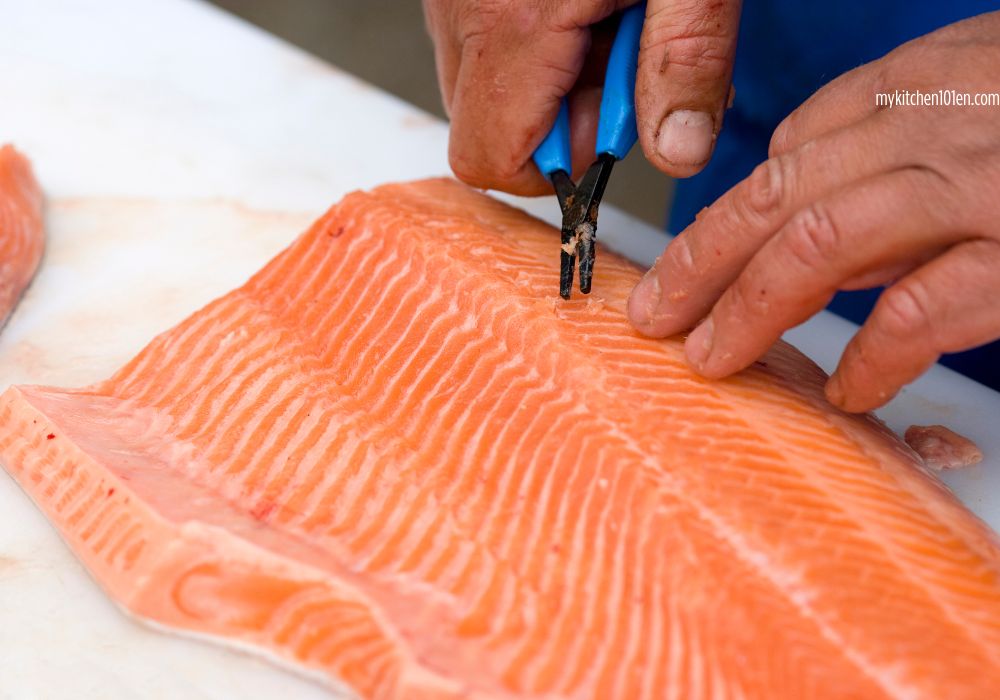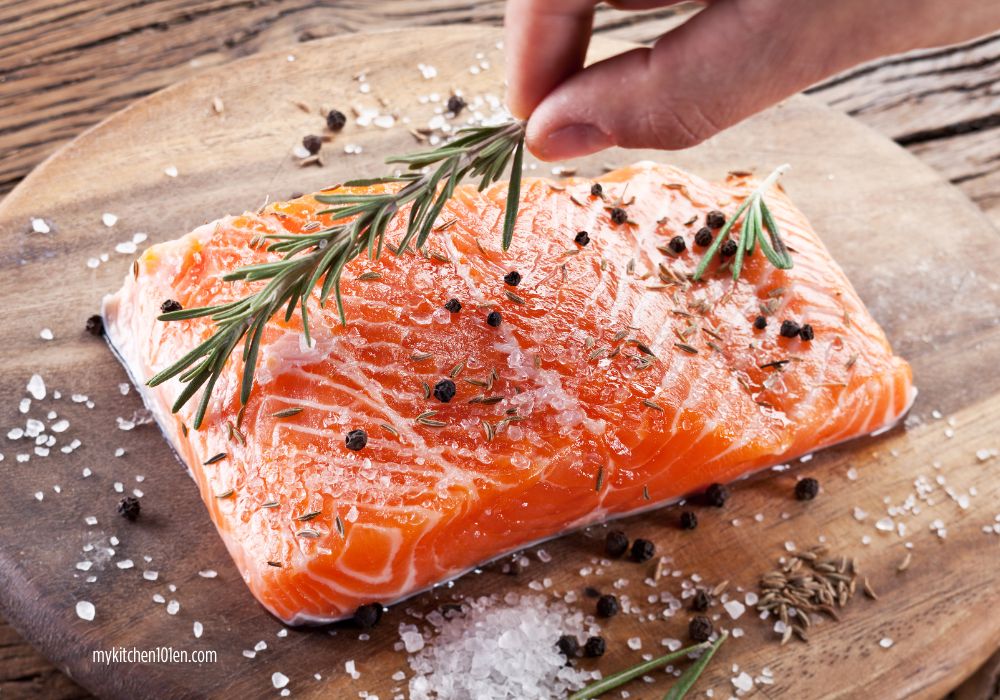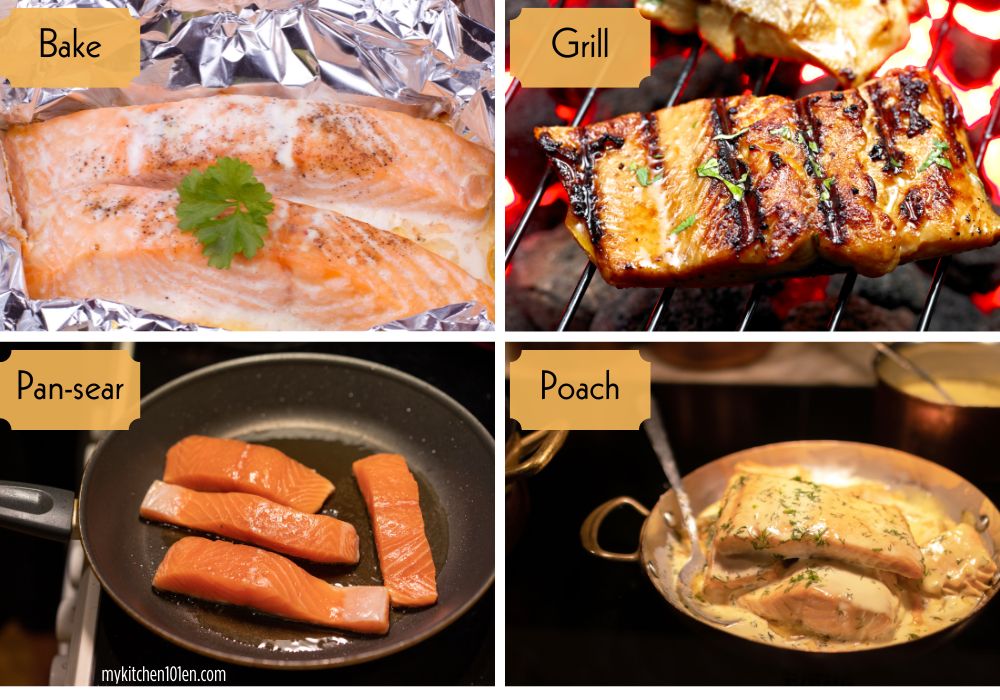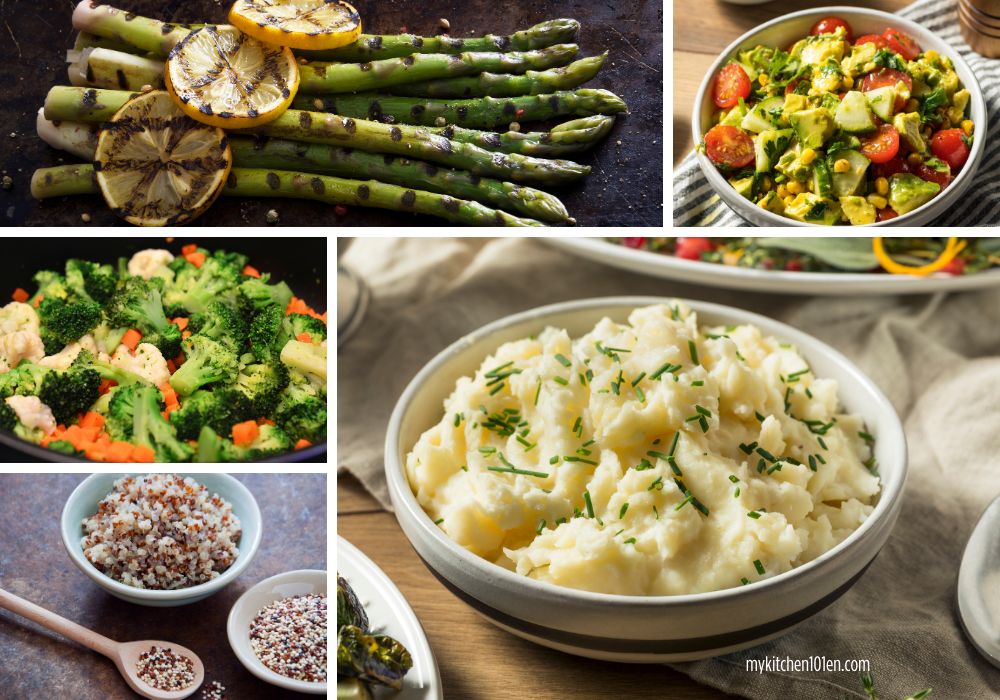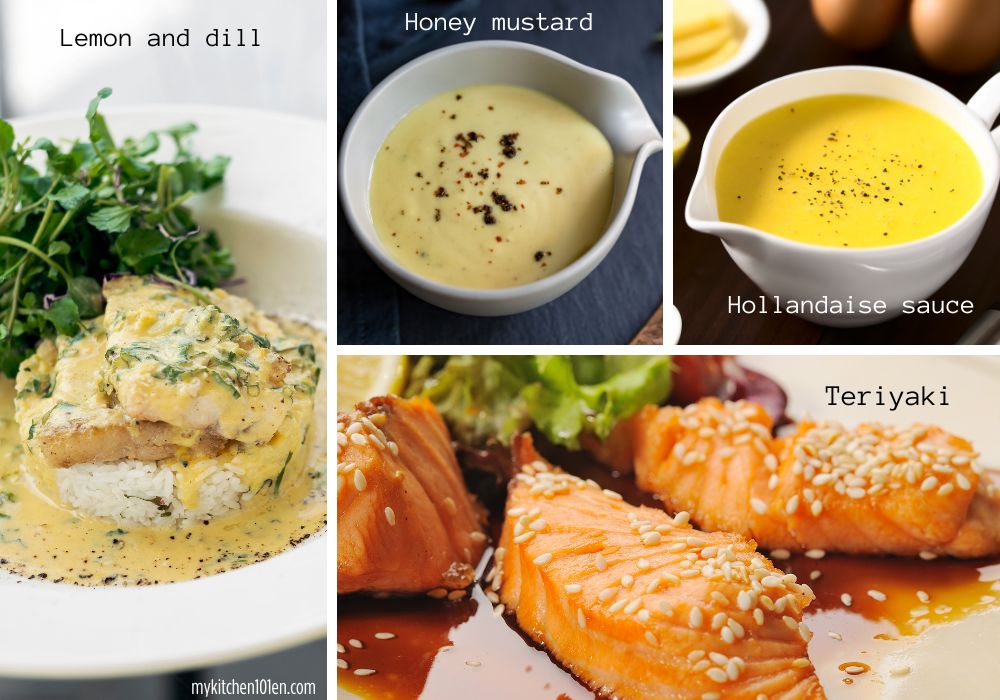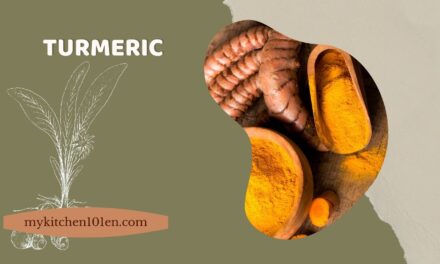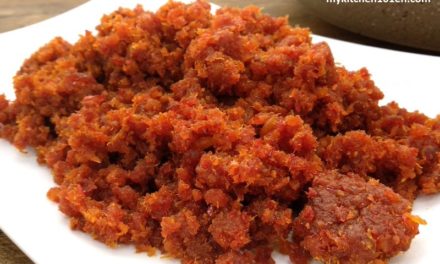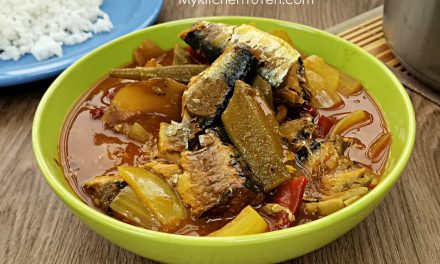Introduction: Salmon, the Popular and Healthy Fish to Cook
Salmon is delicious, nutritious, and worth adding to your regular dinner rotation. Salmon has omega-3 fatty acids, a high-quality source of protein—and many essential nutrients!
However, cooking salmon can be tricky, especially for beginners. If not cooked properly, it can turn out dry and chewy, ruining your meal entirely.
Fear not! This beginner’s guide will walk you through the basics of cooking salmon, so you can enjoy perfectly flaky fish every time.
Table of Contents
Knowing How to Cook Salmon Properly
Knowing how to cook salmon properly is not just about ensuring that it tastes great; there are health considerations at play as well:
Undercooked fish may contain harmful bacteria such as E. coli or listeria which can cause food poisoning.
In addition, overcooking salmon can lead to loss of its natural oils and essential nutrients which are good for heart health and brain function.
So learning how to cook salmon correctly will not only benefit your taste buds but also help maintain your overall health.
How to Choose the Right Salmon
The three most common types of salmon are Atlantic, Chinook (King), and Coho (Silver). However, other varieties include Sockeye-Red and Pink. Each type has a unique taste profile, texture—and nutritional value!
Salmon are known for their remarkable ability to return to the exact spot where they hatched to spawn. After spending several years in the ocean, they can find their way back to their home stream, navigating by smell.
- Atlantic salmon: The most widely available type of salmon in North America. It is known for its mild flavor and tender texture.
- Chinook or King salmon: It has a rich, buttery flavor and firm texture that makes it excellent for grilling or baking.
- Coho or Silver salmon: It has a milder taste than Chinook but still provides the same firm texture with slightly more oil content.
- Sockeye or Red salmon: Known for its deep red flesh color, high oil content, and distinct flavor profile that is both nutty and rich at the same time.
- Pink salmon: It has lower oil content but still has a mild taste and delicate texture that makes it perfect for salads and sandwiches.
Factors to Consider When Choosing Salmon for Cooking
When choosing salmon for cooking, consider factors such as freshness, sustainability practices, and origin.
Freshness can be determined by checking the eyes – they should be clear rather than cloudy. The smell also plays an essential role – fresh salmon smells like seawater rather than fishy.
Sustainability practices refer to how the fish was caught or farmed. Wild-caught salmon typically comes from well-managed fisheries while farmed options can vary in quality based on their farming practices. Look for seafood labels indicating “sustainably sourced” to ensure that your choice supports responsible fishing methods.
Consider your fish’s origin when selecting it for cooking purposes; some regions have higher mercury levels in their fish populations than others – so it is wise to research this beforehand.
When you consider all the factors that go into choosing salmon, it is certain to taste delicious.
Preparing Salmon for Cooking
Cleaning and Scaling the Fish
Before cooking salmon, it’s important to properly clean and scale the fish.
The easiest way to descale salmon is to use a dull knife or scaling tool to scrape the scales off from tail to head.
- Hold the fish firmly with one hand while using the tool with the other hand.
- Rinse it in cold water after scaling to remove any leftover scales.
- After descaling, it’s important to gut and cleans out the cavity of any remaining guts and debris. To do this, cut along the belly of the fish from where its head was down towards its tail.
- Gently open up its belly using your fingers and remove all of its organs with a spoon or your fingers.
- Rinse thoroughly again after cleaning out.
Removing Bones and Skin for Salmon
To remove bones from salmon, use tweezers or pliers to grip each bone at an angle and then gently pull them out in one swift motion. If you’re not confident enough, you can always buy boneless fillets instead.
When removing skin from salmon, use a sharp knife by sliding it between the skin and flesh at one end of each fillet piece at a 45-degree angle while holding onto both ends of each piece tightly with your fingertips so that they don’t move around during this process.
Continue slowly cutting until all skin has been removed.
Regardless of the species, all salmon are anadromous, meaning they’re born in freshwater, migrate to the sea, and return to freshwater to reproduce, or “spawn.”
Salmon Seasoning Options
There are many different options when it comes to seasoning salmon before cooking it. Some popular choices include lemon juice, garlic powder, dill weed, salt, pepper, olive oil, or butter-based marinades like teriyaki or honey mustard.
It’s important not to over-season salmon as it has a delicate flavor that can be easily overpowered. It’s best to use only two or three spices in a recipe.
A simple seasoning of salt and pepper is usually enough to enhance its natural taste. Additionally, avoid adding too much oil or butter as it can make the fish greasy when cooked.
By properly preparing your salmon before cooking it, you’ll end up with a delicious meal that’s both healthy and satisfying!
Cooking Methods for Salmon: Bake, Grill, Pan-sear, and Poach
How to Bake Salmon:
Baking salmon is a popular method because it’s easy and convenient.
- You have to preheat the oven to 400°F (200°C).
- Then, place your seasoned salmon fillet on a baking sheet lined with parchment paper.
- Bake for 12-15 minutes or until the internal temperature of salmon reaches 145°F.
Baking salmon retains its natural juices, keeping it moist. The downside is that you won’t get a crispy crust on the outside.
How to Grill Salmon:
Grilling salmon gives it a smoky flavor that’s hard to beat.
- Oil the grates of your grill, and heat it to medium-high.
- Place your seasoned salmon fillet on the grill skin-side down first to prevent sticking, then flip after about 4-5 minutes when it releases easily from the grates.
- Grill for an additional 4-5 minutes until done.
Grilling also gives you those beautiful grill marks on your fish which can be very impressive! However, be careful not to overcook as this can dry out the fish.
How to Pan-sear Salmon:
Pan-searing will give you a crispy crust on your salmon while keeping it tender and flaky inside.
- Place a non-stick skillet or cast-iron pan over medium heat.
- Lightly coat the pan with oil (such as vegetable or canola oil).
- Place the fillet skin-side down in the pan, pressing gently to ensure even contact with the surface.
- Cook for 4-5 minutes or until golden brown.
- Flip over and cook for another 2-3 minutes until done according to desired doneness level.
The only downside here is that this method requires more attention than others so watch closely!
How to Poach Salmon:
Poaching involves cooking in gently simmering liquid such as water or broth which results in delicate, moist fish with no crispy texture whatsoever!
- To poach the salmon, bring your liquid to a simmer and add the salmon fillet.
- Cook for about 10-15 minutes.
The benefit of poaching salmon is that it’s very gentle on the fish and keeps it moist but not crispy.
Tips for Achieving Perfectly Flaky Fish
No matter which cooking method you choose, there are some basic tips for ensuring perfectly flaky salmon:
- Avoid overcooking: Don’t let your fish dry out! Keep an eye out for signs that it’s done (145°F internal temperature), which will vary slightly depending on thickness.
- Seasoning: Don’t be shy with seasoning! Salmon can handle strong flavors such as lemon or garlic.
- Skin: It’s up to personal preference whether to leave the skin on during the cooking process or remove it prior.
- Rest time: Let your cooked salmon rest for a minute or two before serving so that juices redistribute evenly throughout the fillet.
By following these tips and experimenting with different methods, you’ll soon be able to create perfectly cooked, flaky salmon at home every time!
What To Serve Salmon With?
Salmon is a versatile fish that can be paired with a variety of sides and sauces. In this section, we’ll explore some serving suggestions for your delicious salmon dish.
Pairing with Sides
Many different side dishes go nicely with salmon. Some popular side dishes include:
- Steamed vegetables – a classic side dish include asparagus, broccoli, or green beans.
- Quinoa or rice – from simple white rice to flavorful pilafs.
- Mashed potatoes – the sweetness of the potatoes pairs well with the rich flavor of the salmon.
- Fresh salad – a bed of mixed greens and sliced avocado is always a winner.
- Grilled asparagus
Sauces that Complement the Flavor of Salmon
The key to a delicious salmon dish is in the seasoning. Some classic flavors that pair well with salmon include:
- Lemon and dill – its tangy flavor complements the fish without overpowering it
- Garlic and parsley
- Soy sauce and ginger – sweet and spicy, an Asian-inspired glaze
- Honey mustard
- Hollandaise sauce – its buttery richness pairs perfectly with flaky salmon
- Teriyaki sauce
- Mayonnaise and sriracha hot sauce
Overall, serving suggestions for cooking perfect salmon are endless!
Pairing with sides such as vegetables or rice and adding different sauces that complement the flavor of salmon can make your dish stand out.
Common Mistakes to Avoid When Cooking Salmon
Overcooking or Undercooking the Fish
Cooking salmon can seem tricky, especially if you’re new to it. An inexperienced cook will often either over- or undercook a piece of fish. Overcooked salmon is dry and chewy, while undercooked salmon can be slimy and raw in the middle.
The key to cooking perfect salmon is timing! Ideally, you should cook salmon until its internal temperature reaches 145°F (63°C). This will ensure that it’s fully cooked but still moist and flaky.
Another tip to avoid overcooking or undercooking is to use a timer and check your salmon frequently. Depending on the thickness of your fillet, cooking time may vary anywhere from 10-20 minutes.
If you’re unsure about whether your fish is cooked through, use a fork to gently flake off a small piece from the thickest part of the fillet – it should be opaque but moist.
Using Too Much Seasoning or Sauce
While seasoning and sauce are crucial components of delicious salmon dishes, using too much can overwhelm the natural flavor of the fish. Some seasonings like garlic, dill, and lemon juice perfectly complement the taste profile of salmon without overpowering it.
Be careful not to overuse strong spices such as cumin or chilies. When it comes to sauce for salmon dishes, less is more!
A simple drizzle of olive oil with some salt and pepper may be all you need to enhance its natural flavor. If you do opt for a sauce that complements your dish well- such as hollandaise sauce – then go ahead but keep a light hand while applying them.
Searing Salmon with Skin On
Searing salmon with the skin on is a popular and delicious way to cook it. The skin adds flavor, helps hold the fillet together, and turns delightfully crispy when seared.
When searing salmon with the skin on, it’s generally recommended to start with the skin side down first. This helps achieve crispy skin and ensures that the skin will hold the fillet together during the cooking process. Cooking the skin side first also allows the fish to cook more evenly, as the skin acts as a barrier that slows down the cooking of the flesh.
To achieve a perfectly seared salmon with skin on, follow these steps:
- Preheat a non-stick skillet or cast-iron pan over medium-high heat.
- Lightly coat the pan with oil (such as vegetable or canola oil).
- Season the salmon fillet with salt and pepper.
- Place the fillet skin-side down in the pan, pressing gently to ensure even contact with the surface.
- Cook for 4-5 minutes, then carefully flip the fillet and cook for another 3-4 minutes, or until the desired doneness is reached.
Conclusion
Recap of key points in cooking perfect salmon
To recap, when choosing your salmon, look for fresh, wild-caught fish that is vibrant in color and free from any unpleasant odors.
Before cooking, clean and scale the fish if necessary, remove any bones or skin, and season with your favorite flavors.
When cooking, consider using methods such as baking or grilling for a crispy crust on the outside while maintaining a juicy inside.
Encouragement to try new recipes and techniques
Now that you have a solid foundation in cooking delicious salmon dishes, experiment with different seasoning blends or marinades to create unique flavor profiles with each dish.
Try wrapping your fillets in parchment paper before baking them with vegetables for an easy one-pan meal. Or grill your salmon on a cedar plank for smoky flavor notes.
Remember that practice makes perfect when it comes to perfecting your seafood culinary skills. Don’t get discouraged if your first few attempts at preparing salmon don’t turn out how you envisioned them – keep trying!
With our beginner’s guide as a starting point, you’re now equipped with the knowledge needed to confidently prepare deliciously tender and tasty salmon dishes that will please any crowd. So go ahead and start cooking!
Related:
- Are Potatoes Vegetable
- How Many Grams In An Ounce?
- 6 Easy Recipes of Banana Bread
- Baking Soda vs Baking Powder
Frequently Asked Questions About Cooking Salmon
How long should I cook salmon?
Depending on the cooking method and thickness of the fish, salmon should generally be cooked for 10 minutes per inch of thickness. Grilling salmon takes about 4-6 minutes per side, while pan searing will take 3-4 minutes. A good indicator that your salmon is done is when it turns opaque and easily flakes with a fork.
Can I eat raw salmon?
Although it is possible to eat raw salmon, eating any fish that has not been properly handled or prepared by a professional chef can lead to food poisoning. Eating raw or undercooked fish carries a risk of foodborne illness.
How can I tell when my salmon is done cooking?
Salmon is done cooking when it flakes easily with a fork and has an opaque, pink color throughout. The ideal internal temperature for cooked salmon is 145°F (63°C). To check the temperature of a thick fillet, insert the probe of the meat thermometer into its center.
Should I remove the skin before cooking salmon?
It’s a personal preference whether to remove the skin before cooking salmon. The skin can add flavor and help to hold the fillet together while cooking. If you prefer not to eat the skin, it can be easily removed after cooking by sliding a spatula between the skin and the flesh.
Can I cook frozen salmon without thawing it first?
Yes, you can cook frozen salmon without thawing it first. However, cooking time will need to be increased by approximately 50%. Make sure to check the internal temperature to ensure it reaches 145°F (63°C) before consuming.
What’s the best way to store leftover cooked salmon?
Leftover cooked salmon should be stored in an airtight container in the refrigerator and consumed within 3 days. To reheat, gently warm in the oven or microwave, taking care not to overcook and dry out the fish.
What are the health benefits of eating salmon?
Salmon is a great source of omega-3 fatty acids, which support heart health and brain function. It’s also high in protein and vitamins—making it a nutritious choice for any meal!
Can I use these cooking methods for other types of fish?
Yes, most of these cooking methods can be used for other types of fish. Cooking times and temperatures may vary, so be sure to adjust as needed and always check for proper doneness before consuming.

